Iris diaphragm - Study guides, Class notes & Summaries
Looking for the best study guides, study notes and summaries about Iris diaphragm? On this page you'll find 523 study documents about Iris diaphragm.
Page 3 out of 523 results
Sort by
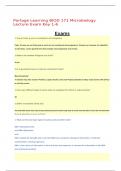
-
Portage Learning BIOD 171 Microbiology Lecture Exam Key 1-6
- Exam (elaborations) • 28 pages • 2023
- Available in package deal
-
- $14.49
- 1x sold
- + learn more
Portage Learning BIOD 171 Microbiology Lecture Exam Key 1-6 Exams 1. What are the two major types of nucleic acids and their roles? DNA- deoxyribonucleic acid RNA- Ribonucleic acid DNA- Cellular life has DNA and a role that DNA has is long-term storage of information, it holds the characteristics of living organisms. RNA- Is the carrier of information in form of amino acid sequence. It converts the information in the DNA and synthesizes proteins Tru...
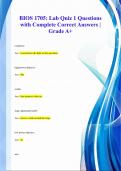
-
BIOS 1705: Lab Quiz 1 Questions with Complete Correct Answers | Grade A+
- Exam (elaborations) • 7 pages • 2024
- Available in package deal
-
- $10.49
- + learn more
condenser Ans: concentrates the light on the specimen high power objective Ans: 40x ocular Ans: lens nearest to the eye stage adjustment knobs Ans: moves a slide around the stage low power objective Ans: 4x arm Ans: use to safely carry the microscope stage Ans: platform on which the slide is mounted iris diaphragm Ans: controls the amount of light reaching the specimen medium power objective Ans: 10x coarse adjustment knob Ans: use to focus at low power ONLY fine adjustment k...

-
Fluoroscopy Test Questions and Answers Graded A+
- Exam (elaborations) • 5 pages • 2024
-
Available in package deal
-
- $12.99
- + learn more
Fluoroscopy Test Questions and Answers Graded A+ What does the automatic brightness control (ABC) do - Answer- allows the radiologist to select an image brightness level that is subsequently maintained automatically by varying the kVp, the mA, or sometimes both. Principal advantage of image-intensified fluoroscopy over earlier types of fluoroscopy is - Answer- increased image brightness The structures in the eye that are responsible for the sensation of vision are called - Answer- rods an...
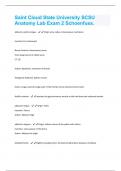
-
Saint Cloud State University SCSU Anatomy Lab Exam 2 Schoenfuss Questions And Answers Rated A+
- Exam (elaborations) • 35 pages • 2024
- Available in package deal
-
- $7.99
- + learn more
abductor pollicis longus - Origin ulna, radius, Interosseous membrane Insertion 1st metacarpal Nerve Posterior interosseous nerve from deep branch of radial nerve C7, C8 Actions abduction, extension of thumb Antagonist Adductor pollicis muscle (note: Longus extends longer part of the thumb, brevis extends shorter part) Achilles tendon - attaches the gastrocnemius muscle to the heel bone aka calcaneal tendon adductor longus - Origin: Pubis Insertion: Femur Action: Adducts thigh adduct...
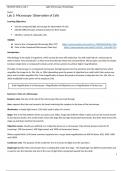
-
BIOS 242 Lab 3: Microscopy- Observation of Cells
- Other • 11 pages • 2023
-
- $19.49
- + learn more
Lab 3: Microscopy- Observation of Cells Learning Objectives: Use the compound light microscope for observation of cells. Identify different types of bacteria based on their shapes. Identify a variety of eukaryotic cells. VIDEOS: a) How to Use a Compound Microscope (Elon TLT) b) Parts of the Compound Microscope (Tami Guy) Introduction: Microbiology is the study of organisms, which cannot be seen with naked eye. You will need help of a microscope to observe these “tiny anim...
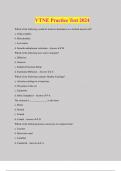
-
VTNE Practice Test 2024 100% Solved
- Exam (elaborations) • 176 pages • 2024
- Available in package deal
-
- $15.49
- + learn more
VTNE Practice Test 2024 Which of the following would be found in abundance in a skeletal muscle cell? a. Golgi complex b. Mitochondria c. Lysosomes d. Smooth endoplasmic reticulum - Answer ️️ -B Which of the following uses active transport? a. Diffusion b. Osmosis c. Sodium-Potassium Pump d. Facilitated Diffusion - Answer ️️ -C Which of the following contains Hyaline Cartilage? a. Articular cartilage in a long bone b. The pinna of the ear c. Ligaments d. Pubic Symphasis - ...
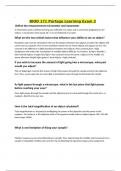
-
BIOD 171 Portage Learning Exam 3 - graded A+
- Exam (elaborations) • 3 pages • 2024
-
- $8.49
- + learn more
..........What are the two critical factors that influence your ability to see an object? Resolution and contrast. Resolution refers to the distance between two objects at which the objects still can be seen as separate. Poor or low resolution means two (or more) objects may appear as one. The contrast is the difference in light absorbance between two objects. Poor contrast gives a high background and makes the visualization of multiple objects difficult. For instance, trying to identify 2 dark...
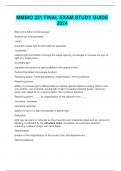
-
MMBIO 221 FINAL EXAM STUDY GUIDE 2024
- Exam (elaborations) • 20 pages • 2024
- Available in package deal
-
- $15.49
- + learn more
MMBIO 221 FINAL EXAM STUDY GUIDE 2024 Who is the father of microscopy? Antonie van Leeuwenhoek Lamp: produces visible light to illuminate the specimen Condenser: collects light and directs it through the stage opening (converges or focuses the rays of light to a single point) Iris diaphragm: regulates the amount of light available to the objective lens Factors that affect microscope function: Resolving power, numerical aperture, magnification, working distance Resolving power: ab...

-
Portage Learning BIOD 171 Final EXAM Questions and Answers 100%Correct 2024-2025 Update
- Exam (elaborations) • 51 pages • 2024
-
- $12.49
- + learn more
True or False: A virus is considered a microorganism. False. Viruses are not living and as such are not considered microorganisms. Viruses can, however, be classified as microbes, a more general term that includes microorganisms and viruses. 1. What is the smallest biological unit of life? A cell. 2. At a generalized level, all cells are comprised of what? Macromolecules* *A student may also answer: Proteins, Lipids, Nucleic acids and Polysaccharides but they must answer with all four t...

-
Biol 150 (Final Lab Exam) Correct 100%(Graded A+)
- Exam (elaborations) • 3 pages • 2024
-
Available in package deal
-
- $9.99
- + learn more
Biol 150 (Final Lab Exam) Correct 100%(Graded A+) Objective Lens - ANSWER Magnifies image on the slide Coarse/fine adjustment knobs - ANSWER Focus on the slide Ocular Lens - ANSWER Further magnifies the image on the slide Iris Diaphragm - ANSWER Regulates light passing through the condenser Condenser - ANSWER Focuses light on the slide Mitosis - ANSWER Cell division involving distribution of duplicate sets of chromosomes from parent to two daughter cells Cytokinesis - ANSWER D...

How did he do that? By selling his study resources on Stuvia. Try it yourself! Discover all about earning on Stuvia


